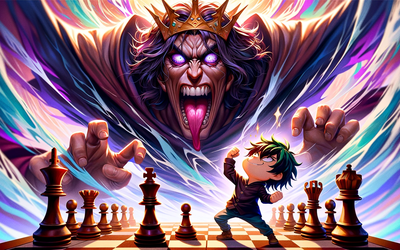
How to Beat Stronger Players: Part 2
Hi everyone! I’m back with the second part of my series on beating stronger opponents. In part 1 I talked about my personal experience with learning how to play against higher rated opposition, and discussed one of the most common ways people hurt their chances against them, by playing too passively. In part 2 I’ll talk about a less intuitive but just as pervasive way I’ve seen players go astray against higher rated opposition.Part 1: https://lichess.org/@/mmsanchezchess/blog/how-to-beat-stronger-chess-players-part-1/Sj4sGdOq
Part 3: https://lichess.org/@/mmsanchezchess/blog/how-to-beat-stronger-players-part-3/JWAixlb2
2) Entering too many forcing lines/ Playing too directly
Where playing too passively cost me many games against higher rated players when I was rated below 2000, I actually think this mistake was more harmful to my later results, and is in general to the results of players between 2000 and 2300. It’s an easier trap for experienced players to fall into, as while most of them will realize that passive play rarely yields ideal results, forcing lines, and direct play are the correct path in many positions. The issue of course, comes in when it is not. There are some positions where the best lines involve maneuvering and slow play, and where your advantages can be reaped more from maintaining the nature of the position than transforming it.
What makes forcing lines attractive is that you know what is going to happen next, and you feel more in control of what your higher rated opponent can do to you. For many people playing against higher rated players, ambiguity can be very scary, and a forced variation feels like a nice insurance policy that the position is not going to trend away from you or take a false turn you don’t expect in the immediate future. While this can be tempting and feel safe, the next two games clearly illustrate the potential downside to such an approach.
Two painful losses that clearly show how the temptation to enter forcing lines can easily backfire. If I was feeling more confident I wouldn’t have played c5 against GM Antipov or Nd4 against IM Mardov, but the false security of a forcing variation led me down the wrong path. You are almost never going to beat stronger players lacking faith in your position. Instead if you play to meet the nature of position, playing slowly and developing small advantages when appropriate, but still going down forcing variations when they seem fruitful, you’ll be a scary opponent for even stronger opponents to face.
To finish off I’ll show a happier example from my tournament play, where by forgoing a concrete line and trusting the long term attacking potential of my position, I was able to score an emphatic victory against a tough opponent.
I’ll leave it there for today. Next week I’ll be covering a third and final common mistake people make against higher rated opponents, before moving on to a new topic. Hope you all enjoyed!
More blog posts by mmsanchezchess

How to Play against Lower Rated Opponents Part 1: Know your Advantage
Previously, I have written a series on how to do well and score upsets against higher rated opponent…
Level Up Your Endgames Part 3: 2 Rook Endgame Ideas You Have to Know
In my first section I talked about how the strength of passed pawns depends significantly on what fi…
Level up your endgames Part 2: The Strengths and Weaknesses of the Minor Pieces
Hi Everyone! I’m back with the second part of my series on leveling up your endgame play. In my firs…